

Several works on view at “Sam Spratt: The Monument Game” at the Docks Cantiere Pietro Cucchini in Venice.
Image courtesy 1OF1. Photography by Anna Blubanana studio.
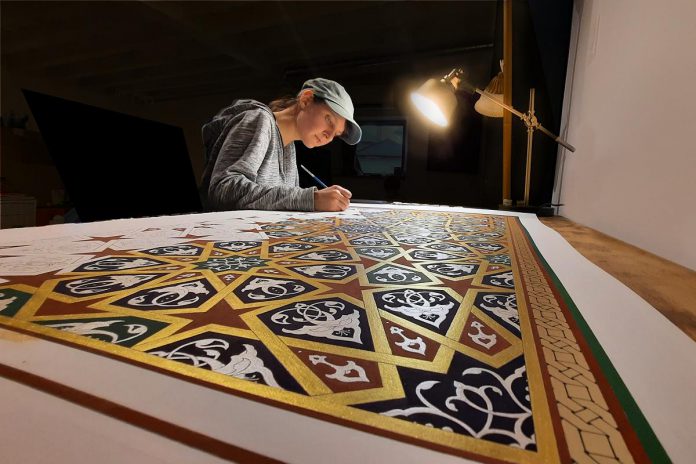
When Nogojiwanong-Peterborough artist Gillian Turnham first encountered Islamic tradition in 2012, it wasn’t something she initially explored artistically. Her engagement with the geometric patterns in the Islamic artistic tradition came later, stemming from an exploration of esoteric Islam.
By the time Turnham came across and became curious about Islamic geometric patterns — what drives them and how they are constructed — she had established art design and Islamic tradition with separate roots. Nevertheless, from first working with her hands as a child in England, to designing and building art in the PCVS arts program in Peterborough, to her focus on architecture and ornamental art after graduating from the Nova Scotia College of Art and Design, the turn to traditional Islamic art was a natural extension of her creative life.
“It opened up a whole entire world for me,” Turnham recalls. “And since that point, almost everything I’ve done artistically has been Islamic geometry.”
VIDEO: Samples of Gillian Turnham’s work
[embedded content]
Tweet this quote
Turnham hopes to open that world for listeners with a six-episode radio series she is producing during her Trent Radio “Your Radio is Their Stage” artist residency. The radio series will be broadcast on Sunday (February 6) and explore the theory, symbolism, and cultural context behind traditional Islamic art.
“I think there’s a growing interest, but also a lack of basic contextual literacy and understanding in how to view contemporary traditional art,” says Turnham. “Peterborough is becoming more diverse in our demographics. I think it’s good to gain some literacy in other artistic traditions and other ways of thinking about the world, especially now that there is a lot more interest in things like mandalas and yoga and meditation.”
“For these traditional aspects that we’re bringing into contemporary life, it’s important to have a framework for engaging with them that is respectful and genuine and culturally appropriate,” she adds.
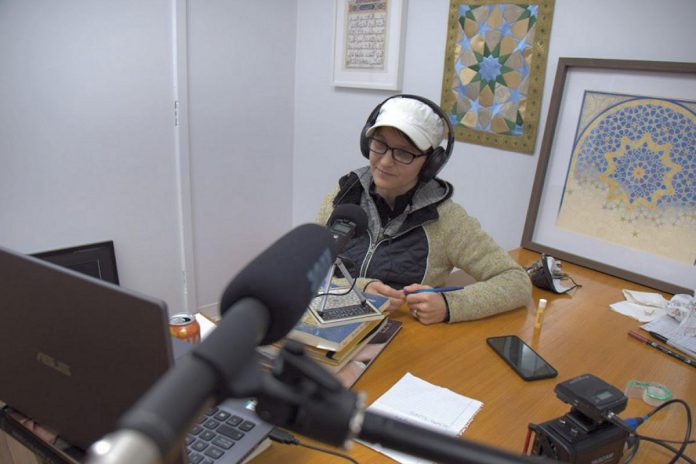

Before exploring Islamic traditions, much of Turnham’s artistic grounding looked to European and Western traditions. Since practising traditional Islamic art, she’s noticed that many people have a growing interest in the form and patterns, but lack understanding of its framework.
For instance, Turnham says traditional art is treated differently in the West because of differences in ideology about progress and time.
“We think about traditional arts as existing in museums, or being something that we need to preserve, rather than being something alive and meaningful in a contemporary sense,” she explains.
Tweet this quote
For Turnham, when the opportunity came to transfer her artistic practice into audio with her “Your Radio is Their Stage” artist residency at Trent Radio, that meant sharing the cultural traditions and contexts from which her work derives meaning. Through the residency, Turnham has received mentorship, equipment, training, and support to develop the radio series.
“It’s a relatively standard talk radio format, in which I bring on a number of guests to the show and we discuss various topics within Islamic art rooted very much in the experience of contemporary artists working in the field today,” Turnham says. “We also explain some of the history and give the background context for people who might not have encountered this before.”
The topics to be covered within the series, which is called ‘Beauty, Goodness, Truth’, include:
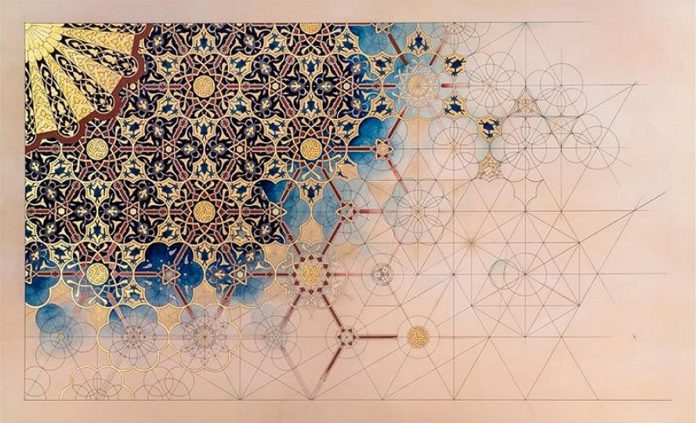

Turnham put a lot of thought into the structure and formulation of the series. Six one-hour episodes is not a lot of time, considering Turnham’s nine years of research on the topic.
“There was a lot of formulation in terms of all the information that I wanted to get across and how I could structure that,” Turnham says. “They’re not scripted — they’re all spontaneous conversations.”
The series features conversations with Adam Williamson, Ameet Hindocha, Eman Hijazi, Paul Barchilon, and Samira Mian, many of whom live in different countries. Figuring out how to get a high-quality audio recording of Zoom conversations with people from around the world was an added challenge for Turnham’s project, although she prevailed.
“I have been finding it a little more intuitive than I thought that I would,” Turnham says. “I’ve had great support from Trent Radio and from Laurel Pollock on that regard as well.”
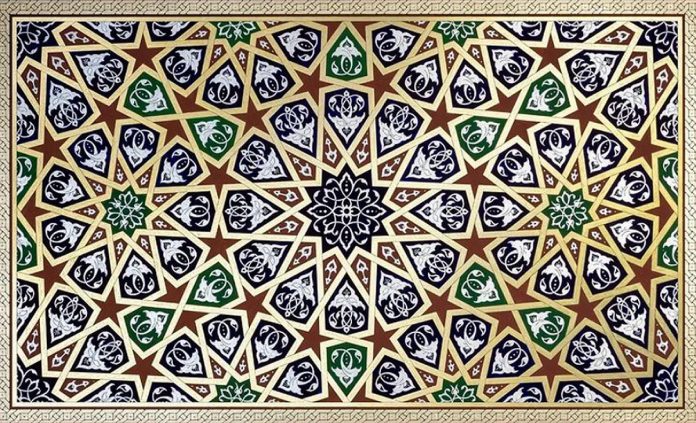

Turnham has created show notes for listeners of the series, which will be available on her website at www.gillianturnham.com. For each episode, listeners will find visuals and further readings on the topics discussed.
While this is her first time learning audio as a medium, it is not the first time Turnham has shifted her artistic practice to a new medium. Originally a fine-metal sculptural artist, she expanded her artistic practice to work with wood and stone as well as hand-pierced metal, creating miniature sculptural works that explored elements of structure and traditional patterns.
She then became interested in tessellation — covering a surface with geometric shapes with no gaps or overlaps — and, in 2014, began focusing on the complex geometric patterns of the Islamic tradition. Turnham recently spent three years in southern Spain, where she immersed herself in the study of the Islamic geometric tradition. There, she created hand-sewn tapestries and original drawings and designed a series of mechanical clocks that incorporate traditional Islamic geometric patterns with other tessellating forms.
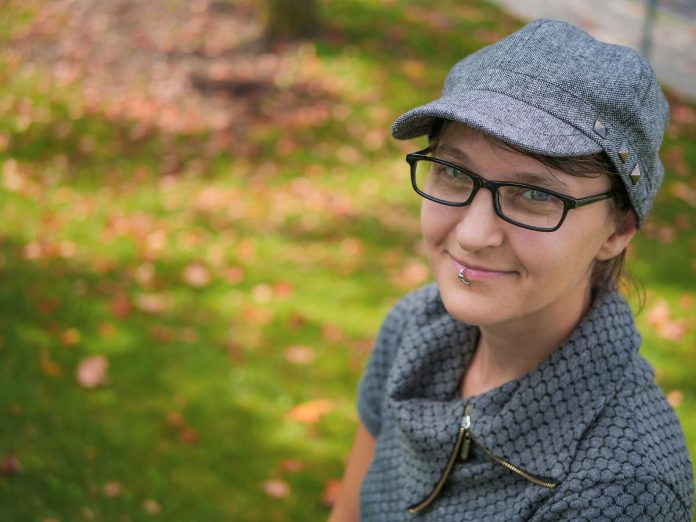

Since the pandemic, her artistic expression of the Islamic tradition has been primarily through painting.
“With the pandemic and all of the lockdowns, I only had access to my domestic space,” Turnham explains. “Painting made a lot more sense within those confines, and it was something that I hadn’t been particularly gripped by before. By that point, my work was already very firmly rooted in Islamic geometry, and having the opportunity to explore that in painting was different from any previous experience.”
With its underlying mathematical framework, the geometry of Islamic art is based on simple forms that are combined, duplicated, and interlaced. The resulting intricate, symmetrical patterns represent unity and order while giving the artist an exceptional degree of flexibility and freedom of expression — an important balance according to Turnham.
“If you create a way of existing in the world that is connected to balance, it retains value without being in a constant process of change,” she says. “Change is inevitable. We don’t have to fight for that. But fighting for the connection — that essential harmonic resonance — has value now more than ever.”
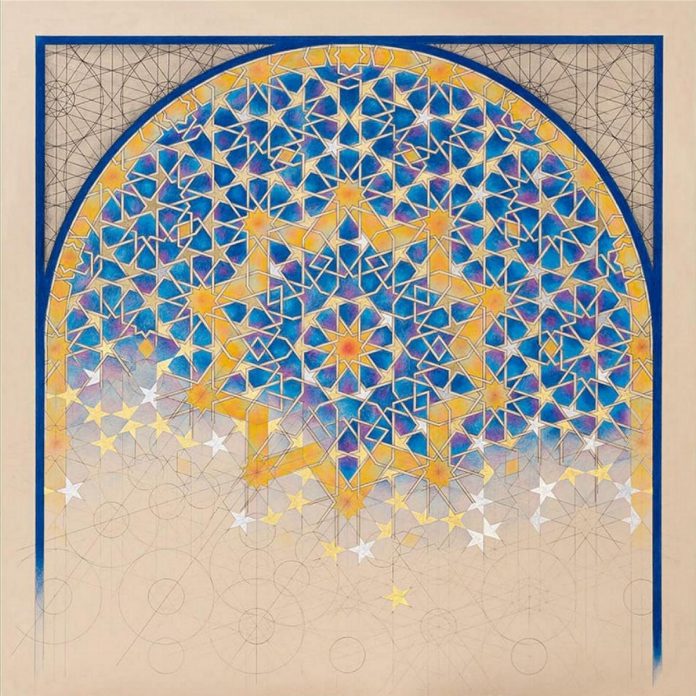

To learn more about Turnham’s traditional methods and designs, visit her website at www.gillianturnham.com. You can also follow her on Instagram @gillianturnham.
Turnham’s radio series is set to broadcast from 6 to 7:30 p.m on Sunday, February 6th on Trent Radio at 92.7 CFFF FM in Peterborough, 287 on Cogeco Cable, and online at www.trentradio.ca.
Trent Radio’s “Your Radio Is Their Stage” artist residency project runs until March 2022, with Turnham’s residency concluding on February 6.
Textile artist Melanie McCall was the first to complete her residency on October 17, followed by Jose Miguel Hernandez on November 14 and JoEllen Brydon on December 12. Gillian Turnham’s February 6 residency will be followed by John Marris (community arts). Poet Justin Million’s residency, originally scheduled from December 5 to January 9, is being rescheduled.
The reimagined work of all participating artists will also be broadcast in April 2022.
“Your Radio Is Their Stage” is made possible by the Community Radio Fund of Canada, the only organization mandated to support campus and community radio stations in Canada financially.
This story was created in partnership with Trent Radio, a producer-oriented broadcast facility that started as a Trent University student club in 1968. Sponsored and designed by students from Trent University, Trent Radio incorporated as a registered charity in 1978. Trent Radio currently holds a Community Broadcast License, and is a resource that is shared with the Nogojiwanong-Peterborough community.
Digital artist Sam Spratt is living the artist’s dream. This week, he celebrated the opening of “The Monument Game,” his first-ever art show. But it wasn’t a group show in some DIY space in New York, where he is based, like so many artists typically start out, but a solo exhibition in Venice, during the art world’s biggest event of the year—the Venice Biennale. How did Spratt–a virtually unknown name in the art world–make such a tremendous leap? With a little help from his friends, of course, including Ryan Zurrer, the venture capitalist turned digital art champion.
“Something the capital ‘A’ art world doesn’t recognize is the power of the collective, it sometimes leans into the cult of the individual,” Ryan Zurrer told ARTnews during a preview of the opening. “But this show is supported by the entire community around Sam.”
Spratt’s Venice exhibition was put on by 1OF1 Collection, a “collecting club” set up by Zurrer to nurture digital artists working in the NFT space. Since its launch in 2021, 1OF1 has been uniquely successful in bridging the gap between the art world and the Web3 community. Last year, 1OF1 and the RFC Art Collection gifted Anadol’s Unsupervised – Machine Hallucinations – MoMA to the museum, after nearly a year on view in the Gund Lobby. Zurrer also arranged the first museum presentations of Beeple’s HUMAN ONE, a seven-foot-tall kinetic sculpture based on video works, showing it first at Castello di Rivoli in Italy and the M+ Museum in Hong Kong, before sending it to Crystal Bridges Museum of American Art in Arkansas.
With “The Monument Game,” Zurrer is once again placing digitally native art at the center of the art world. While Anadol and Beeple had large cultural footprints prior to Zurrer’s patronage, Spratt is far earlier in his career. But, what attracted Zurrer, he said, was the artist’s shrewd approach to building a dedicated, participatory audience for his work. He did so by making his art a game.
“When I first started looking at NFTs, I spent a long time just figuring out who the players were,” Spratt told ARTnews. “The auctions were like stories in themselves, I could see people’s friends bidding, almost ceremonially, to give the auction some energy, and then other people would come in, and it would get competitive, emotional.”
Spratt released his first three NFTs on the platform SuperRare in October 2021. The sale of those works, the first from his series LUCI, was accompanied by a giveaway of a free NFT to every person who put in a bid. Zurrer had been one of those underbidders (for the work Birth of Luci). While Spratt said the derivative NFTs were basically worthless, he wanted to give something back to each bidder. Zurrer, and others it seems, appreciated the gesture and Spratt quickly gained a following in the Web3 space. The offerings he gave, called Skulls of Luci, became Sam’s dedicated collectors that now go by The Council of Luci. 47 editions were given out and Spratt held back three.
All the works from LUCI are on view at the Docks Cantiere Cucchini, a short walk from the Arsenale, past a rocking boat that doubles as a fruit and vegetable market and over a wooden bridge. Though NFTs typically bring to mind glitching screens and monkey cartoons (ala Bored Ape Yacht Club), the ten works on view depict apes in a detailed, painterly style and emit a soft glow. Taking cues from photography installations, 1OF1 ditched screens in favor of prints mounted on lightboxes.
“We don’t want it to look like a Best Buy in here,” said Zurrer.


Several works on view at “Sam Spratt: The Monument Game” at the Docks Cantiere Pietro Cucchini in Venice.
Image courtesy 1OF1. Photography by Anna Blubanana studio.
Each work represents a chapter in a fantasy world that Spratt dreamed up. Though there’s no book of lore to refer to, there seems to be some Planet of the Apes story at play in which an intelligent ape lives alongside humans, babies, and ape-human hybrids. Spratt received an education in oil painting at Savannah College of Art and Design and he credits that technical training with his ability to bring warmth and detail to the digital works. He and the team often say that his art historical references harken to Renaissance and Baroque art, though the aesthetics—to my eye—seem to pull from commercial illustration and concept art. That isn’t too surprising given that this was the environment that Spratt started off in after graduating SCAD in 2010.
“After school I was confronted with the reality that for a digital artist the only path was commercial,” Spratt said.
He did quite well on that path, producing album covers for Childish Gambino, Janelle Monae, and Kid Cudi and bagging clients like Marvel, StreetEasy, and Netflix. Spratt also enjoys a huge audience of fans who have followed him as he’s migrated from Facebook to Tumblr to Twitter and Instagram, posting his hyper-realistic fan-art on each platform. Despite the apparent success, Spratt spoke of the work with bitterness.
“I was a gun for hire. A mimic, hired to be 30% me and 70% someone else,” he said.
Spratt’s personal life blew up when he turned 30 and he traced some of the mistakes he made in his relationships with the fact that he had spent so much of his career “telling other people’s stories.” NFTs seemed like a way out of commercial illustration and a way into an original art practice.
For his latest piece in the LUCI series, Spratt digitally painted a massive landscape set in this ape-human world titled The Monument Game. For the piece, Spratt initially sold NFTs that would turn 209 collectors into “players” (since another edition of 256 NFTs was given to the Council to “curate” new champions”). Each player would then be allowed to make an observation about the painting. The Council of Luci would vote on which three observations were best, and those three Players would receive one of the Skulls of Luci NFTs that Spratt held back. By creating these tiers of engagement, with his Council and player structure, Spratt pushes digital collectors to give the kind of care to his work that more traditional collectors do.


A work at “Sam Spratt: The Monument Game” at the Docks Cantiere Pietro Cucchini in Venice.
Image courtesy 1OF1. Photography by Anna Blubanana studio.
“Jeff Koons said that the average person looks at a work of art for twenty seconds,” Lukas Amacher, 1OF1’s Artistic Director and the curator of the show, told ARTnews. “Sam has found a way to get people to engage in his work for much longer.”
The game Spratt has designed for the Venice exhibition might seem too gamified to fit the art world’s notion of art, but as Amacher and Zurrer suggest, in the Web3 environment, value is built by finding alternative ways to create investment and attention in what are typically immaterial digital artifacts. And it’s working. Thus far, the LUCI series has generated $2 million in primary sales and about $4 million in additional secondary volume. The challenge now, as it has been for the past three years, is to see if art’s gatekeepers will take this work seriously.
At the presentation of The Monument Game in Venice, an observation deck, built by platform Nifty Gateway, sits in front of the mounted work. Participants can click on the painting on the screen and write down their observations of the work in front of them, no NFT required. The first observation came from star curator Carolyn Christov-Bakargiev, the director of Castello di Rivoli and curator of Documenta 15: a tribute to art dealer Marian Goodman. The second was from Zurrer. Who’s next?
“Sam Spratt: The Monument Game” is on view until June 21 at the Docks Cantiere Pietro Cucchini in Venice.
Take in improv comedy, art discussions and shows, locally-produced theatre and live instrumental or choral music.
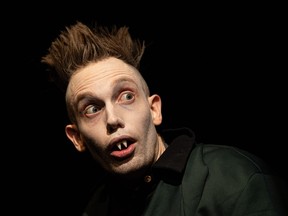

Unseasonable snow this week isn’t slowing the arts down; nor should it hamper the enjoyment of events around town. Get out and take in a variety of comedy shows, art exhibitions and theatre this weekend.
1 — Laugh along with the Soaps
Article content
Saskatoon Soaps Improv Comedy presents We Love the ’90s. Return to the 1990s improv-style, complete with flannel, grunge and gangsta rap jokes coming faster than the old dial-up internet connection. The troupe performs live comedy based on audience suggestions, so be prepared with your classic references and ideas. The all-ages show is Friday at the Broadway Theatre at 8 p.m. Learn more at broadwaytheatre.ca.
Advertisement 2
Article content
2 — Chat with a local artist and take in an exhibition
The Ukrainian Museum of Canada presents an artist talk by its second artist in residence, Amalie Atkins. The Saskatoon-based artist discusses her residency and how her creative expression resonates with the history of Ukrainian heritage. The free event is Saturday at the museum at 3 p.m. Atkins’s exhibition will be on display through May 18. Learn more at umcnational.ca.
GlassArt showcases glasswork by members of the Saskatoon Glassworkers Guild. The annual show features unique works made through a variety of processes and techniques. Artists are in attendance and there will be some demonstrations. The exhibition runs Friday through Sunday in the Galleria at Innovation Place. Learn more at saskatoonglassworkersguild.org.
3 — Experience live, local theatre
Live Five Independent Theatre presents Bat Brains (or let’s explore mental illness with vampires), a new comedy by Sam Kruger and S.E. Grummett. Inspired by a months-long mental breakdown, the dark comedy follows Scud the vampire, who hasn’t left his house in 53 years. The arrival of an unexpected visitor launches Scud on a journey through his home, his mind and beyond. The show opens Friday and runs to April 28 at The Refinery. Learn more at ontheboards.ca.
Advertisement 3
Article content
4 — Sing along with a local choir
The Saskatoon Men’s Chorus presents the spring concert, Meetin’ Here Tonight. Enjoy gospel and classic favourites with special guests: bassist Bruce Wilkinson, baritone Adam Brookman and the Outlook Men’s Chorus. Sunday at Zion Lutheran Church at 2:30 p.m. Learn more at saskatoonmenschorus.ca.
Cecilian Singers present their spring concert, Come Sing with Me. The singers are joined by three guests: soprano Kelsey Ronn, violinist Wagner Barbosa and percussionist Darrell Bueckert. The concert is Sunday at Grosvenor Park United Church at 3 p.m. Learn more at ceciliansingers.ca.
5 — Listen to historic instruments
The University of Saskatchewan presents Rawlins Piano Trio, the final concert of the season in the Discovering the Amatis series. The chamber music performance features violinist Ioana Galu and cellist Sonja Kraus from the piano trio. They are joined by flutist Joey Zhuang and violinist Véronique Mathieu. Showcasing the historic Amati string instruments, the concert is Sunday at 3 p.m. in Convocation Hall at the U of S. Learn more at leadership.usask.ca.
Recommended from Editorial
With some online platforms blocking access to the news upon which you depend, our website is your destination for up-to-the-minute news, so make sure to bookmark thestarphoenix.com and sign up for our newsletters here so we can keep you informed.
Article content
In 2023, Boris Eldagsen revealed that he won a prestigious photography award by submitting an AI-generated image. Now, a London gallery is putting on an exhibition of his work to demonstrate the power of AI in art.
Not long after the Sony World Photography Award Creative Category winner was announced last year, the victor came clean with a surprising revelation. German photographer Boris Eldagsen admitted that his first prize-winning photograph ‘The Electrician’ was actually an AI-generated image.
Eldagsen had created the image using the popular AI-image creating tool DALL-E 2. He turned down the prize, citing his motivation for entering to see if “competitions are prepared for AI images. They are not.”
A year on from his famous refusal, the Palmer Gallery in London is hosting an exhibition of his and other artists’ works to demonstrate the ways art and AI are being used together.
‘Post-Photography: The Uncanny Valley’ features the works of Eldagsen alongside artists Nouf Aljowaysir and Ben Millar Cole. Eldagsen is exhibiting ‘The Electrician’ as part of a series of photography works that blend natural imagery with the synthetic.
Saudi-born and New York-based artist and design technologist Aljowaysir has examined the biases in AI-image creation in her work Ana Min Wein: Where am I from?, to recover her Saudi Arabian and Iraqi lineage from more the stereotypes AI tools rely upon.
British artist Millar Cole’s work toys with the now-publicly understood telltale signs of AI-doctored images and blurs that line with more sophisticated imagery, to create an uncannily off image.
“The artists in the exhibition engage with the current possibilities of creative collaboration with AI tools, harnessing the unique affordances brought on by the various technologies, whilst thinking about their implications,” says AI-art curator Luba Elliott.
“Image recognition tools highlight the imperfection of the machine gaze, whereas photorealistic text-to-image models focus on portraying our collective imagination down to the smallest detail, with the prompt engineer at the steering wheel – taking the viewer to the next stage of art history,” Elliott continues.
The term “uncanny valley” was first invented in 1970 by Japanese robotics professor Masahiro Mori. He described it as the way that humans will increasingly empathise with anthropomorphous-robots until a threshold when they become too humanlike and we find them unsettling.
As a concept, the uncanny was popularised by psychologists Ernst Jentsch and Sigmund Freud in their description of how familiar things can become strange when they present themselves as a facsimile of another part of ordinary life – they used dolls as a primary example.
While the Palmer Gallery is embracing a dialogue between AI and contemporary artists, other artists have been less willing to engage with the controversial technology.
Earlier this month, over 200 musicians signed an open letter from Artist Rights Alliance calling on artificial intelligence tech companies, developers, platforms, digital music services and platforms to stop using AI “to infringe upon and devalue the rights of human artists.”
Signatories of the letter included: Stevie Wonder, Robert Smith, Billie Eilish, Nicki Minaj, R.E.M., Peter Frampton, Jon Batiste, Katy Perry, Sheryl Crow, Smokey Robinson, and the estates of Bob Marley and Frank Sinatra.
While the full letter did acknowledge the value that AI could bring to areas of art, it was primarily concerned with the way non-creatives will rely on these nascent tools to further undermine the value of human creativity.
“Unchecked, AI will set in motion a race to the bottom that will degrade the value of our work and prevent us from being fairly compensated for it,” the letter writes. “This assault on human creativity must be stopped. We must protect against the predatory use of AI to steal professional artists’ voices and likenesses, violate creators’ rights, and destroy the music ecosystem.”
Similarly, Australian musician Nick Cave has spoken out against AI’s influence on art. When sent the lyrics to a ChatGPT generated impression of his work, he responded vociferously.
“Songs arise out of suffering, by which I mean they are predicated upon the complex, internal human struggle of creation and, well, as far as I know, algorithms don’t feel. Data doesn’t suffer. ChatGPT has no inner being, it has been nowhere, it has endured nothing, it has not had the audacity to reach beyond its limitations, and hence it doesn’t have the capacity for a shared transcendent experience, as it has no limitations from which to transcend.”
“ChatGPT’s melancholy role is that it is destined to imitate and can never have an authentic human experience, no matter how devalued and inconsequential the human experience may in time become,” Cave said.
During last year’s Writers Guild of America (WGA) strike that demanded restrictions on the use of AI to replace creative work, I also wrote against the over-valuation of AI’s talents: “The real human experiences that inspire art is what makes us fall in love with them. AI may be increasingly accurate at capturing an artist’s aesthetic, but that’s only skin-deep. It may be a useful tool for many aspects of an artist’s career, but it could never replace an artist entirely.”




UK Mulls New Curbs on Outbound Investment Over Security Risks – BNN Bloomberg
DJT Stock Rises. Trump Media CEO Alleges Potential Market Manipulation. – Barron's




Auston Matthews denied 70th goal as depleted Leafs lose last regular-season game – Toronto Sun
BC short-term rental rules take effect May 1 – CityNews Vancouver
Trump Media alerts Nasdaq to potential market manipulation from 'naked' short selling of DJT stock – CNBC
Collection of First Nations art stolen from Gordon Head home – Times Colonist




Benjamin Bergen: Why would anyone invest in Canada now? – National Post




Save $700 Off This 4K Projector at Amazon While You Still Can – CNET
Comments